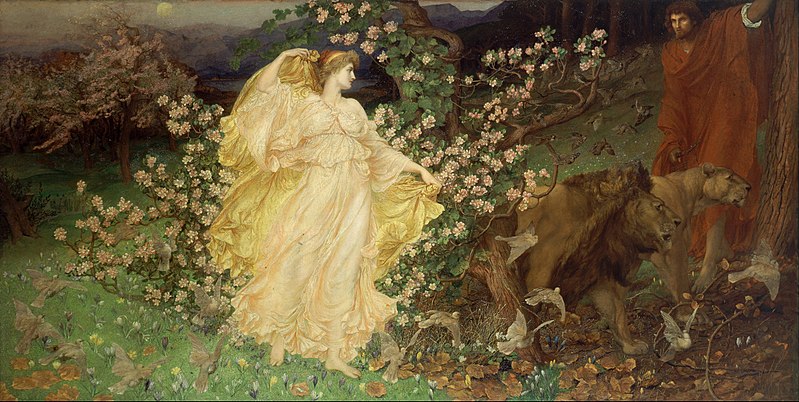Anchises, a prince from Dardania, holds a modest yet captivating position in Greek mythology, known chiefly for his love affair with the goddess Aphrodite. This mortal’s tale, though not as heralded as those of Achilles or Odysseus, carries a narrative of love, loss, and the intertwining fates of mortals and gods amidst the backdrop of the Trojan War.
His story begins with a divine infatuation and culminates in the flames of Troy, a city under siege. Through his son Aeneas, a hero of renown, Anchises’ lineage significantly influences the unfolding events of the Trojan War, offering a glimpse into the delicate interplay between divine whims and mortal endeavors.
Anchises Key Facts
| Parents | Capys and Themiste |
| Partners | Aphrodite |
| Siblings | – |
| Offspring | Aeneas |
| Other names | – |
| Roman name | Anchises |
| Best Known Myth | Love affair with Aphrodite |
Name and Etymology
Anchises, a name echoing through the annals of Greek lore, carries with it a tale of divine love and mortal endurance. The etymology of Anchises’ name isn’t entirely clear, yet it’s a name that would forever be intertwined with the Trojan saga. His Roman counterpart shares the same name, a commonality that bridges the mythic landscapes of Greece and Rome.
The epithets and alternative names for Anchises are scarce, perhaps a reflection of his mortal status amidst a cast of divine and heroic figures. Yet, his name stands unshadowed in the narrative of his divine love affair, a tale that transcends the mortal realm and delves into the hearts of the gods.
Anchises Family and Relationships
Anchises was born into royalty, the son of Capys and Themiste. His father, Capys, was a king of Dardania, a region neighboring Troy, and his mother, Themiste, was a noblewoman. This lineage not only tied him to the royal blood of Dardania but also set the stage for the divine encounter that would forever change his life.
His love affair with Aphrodite is the cornerstone of his mythic narrative. The goddess, smitten by his beauty, descended from Olympus to share a mortal’s bed. From their union, a hero was born – Aeneas, who would later become a key figure in the Trojan War and the legendary founder of Rome.
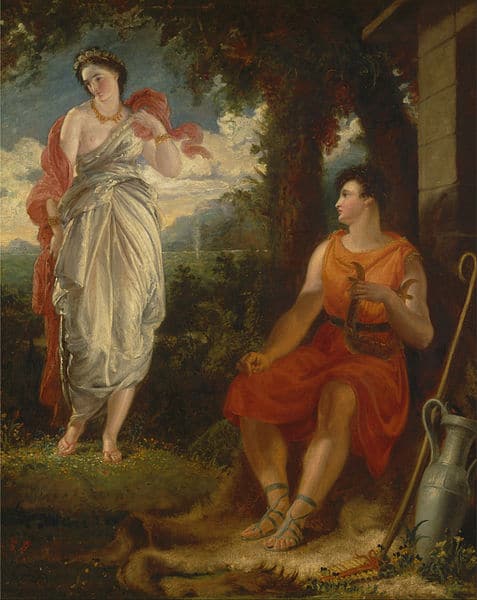
Anchises’ relationships extend beyond the romantic realm. His interactions with other figures of the Trojan saga, like Menelaus and Agamemnon, though not as extensively documented, reflect the interconnected fates of those embroiled in the epic conflict. His narrative is a thread in the intricate web of relationships that shape the tragic tapestry of the Trojan War.
Myths about Anchises
Anchises’ mythic narrative is tender yet consequential, with his affair with Aphrodite forming the cornerstone around which his mythic identity is built. His tale is a soft whisper amidst the roaring narratives of heroism and battle that dominate the Trojan saga, yet it’s a whisper that carries the essence of divine-human interactions characteristic of Greek mythology.
The Divine Romance
The tale begins on the slopes of Mount Ida, where Anchises grazed his cattle. Aphrodite, enchanted by his mortal beauty, descended to earth, veiling her divinity in mortal guise. Their union was brief, yet it bore the seeds of destiny – a son, Aeneas, destined for greatness. The tale is a soft whisper amidst the roaring narratives of heroism and battle that dominate the Trojan saga, yet it’s a whisper that carries the essence of divine-human interactions characteristic of Greek mythology.
The Revelation and the Prophecy
Upon revealing her divine identity, Aphrodite foretold the destiny of their offspring – Aeneas. He was destined to become a hero, his fate intertwined with the fall of Troy and the rise of Rome. This revelation, though filled with promise, also bore the weight of mortality’s transient nature, a theme recurrent in the tales of Greek heroes. Anchises was also given a glimpse of the future, a prophecy that showcased the glory and the hardships that awaited his lineage.
Rescue from Troy
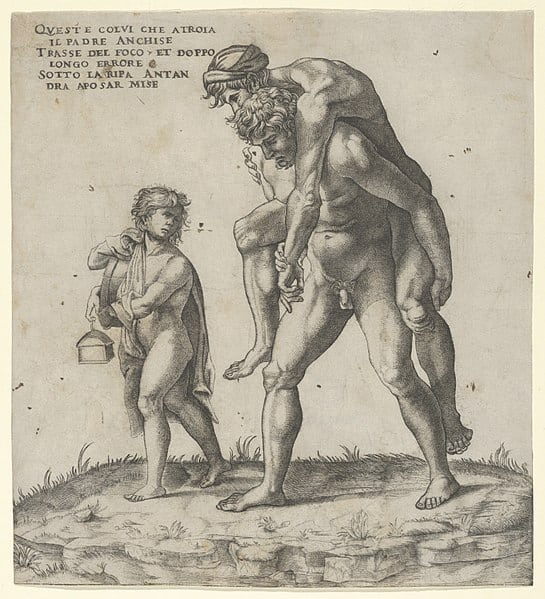
One of the poignant tales associated with Anchises is his rescue from the burning city of Troy by his son, Aeneas. As Troy fell to the Greeks, Aeneas carried his father on his back, embodying the filial duty and love that marked his character. This act of rescue not only showcased the enduring bond between father and son but also symbolized the transfer of legacy from one generation to the next. The image of Aeneas carrying Anchises has since become emblematic of familial duty and the enduring spirit of the Trojan legacy amidst adversity.
The Legacy of Aeneas
Anchises lived to see his son become a hero, yet the flames of Troy’s fall also marked the end of his earthly narrative. His legacy, however, lived on through Aeneas, who would journey to Italy and lay the foundations of Rome. Anchises’ tale, thus, extends beyond his mortal lifespan, echoing through the annals of Rome’s mythic past.
Depiction And Characteristics
Anchises’ depiction in the mythic narrative is one of modesty and mortal beauty. Unlike the heroic figures of Achilles or Hercules, his persona is not adorned with the grandeur of battle or the weight of divine wrath. His allure lies in his humanity, a trait that even captivated a goddess.
His appearance, though not elaborately described in ancient texts, is often imagined as that of a humble shepherd, a mortal untouched by the hubris that often accompanies divine favor. His demeanor reflects a simplicity and humility, traits that stand in stark contrast to the often tumultuous and grandiose narratives of his heroic counterparts.
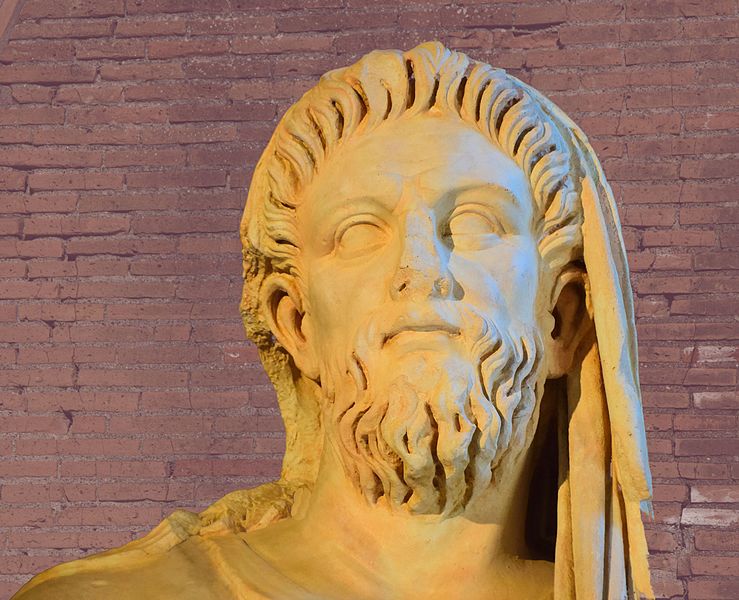
The personality of Anchises, as gleaned from the myths, reflects a mortal grace, a quiet dignity that navigates the turbulent waters of divine favor and mortal endeavor. His tale is a gentle reminder of the softer, more personal dimensions of Greek mythology, often overshadowed by the grand narratives of heroism and divine wrath.
Representations Of Anchises In Art
The artistic representations of Anchises offer a visual narrative that complements the textual tales of his divine romance and mortal endurance. His imagery often captures the tender moments shared with Aphrodite or the nurturing guidance provided to his heroic son, Aeneas.
One of the well-known artworks depicting Anchises is the portrayal of his rescue from Troy by his son Aeneas. This imagery captures the essence of familial love and duty, themes that resonate through the broader narrative of the Trojan War. The visual narrative extends beyond the fall of Troy, encapsulating the enduring legacy of Anchises through the heroic deeds of Aeneas.
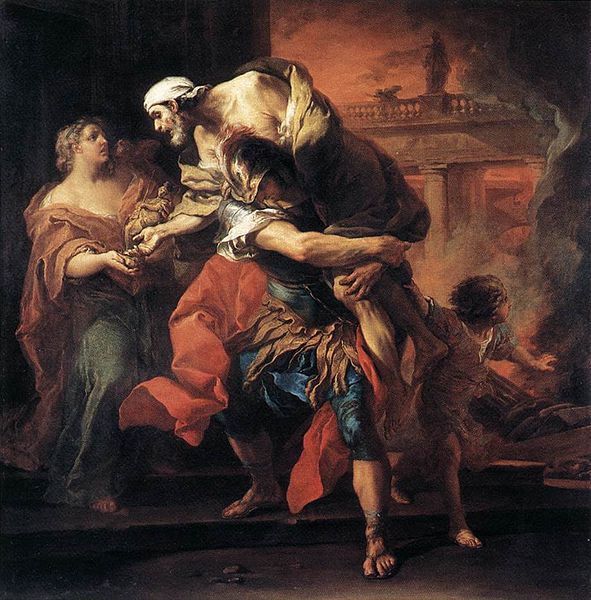
The artistry surrounding Anchises also delves into the tender narrative of his love affair with Aphrodite. Though not as extensively depicted as other mythic romances, the few artistic renditions capture the essence of divine love entwined with mortal beauty. The simplicity and humility of Anchises are often juxtaposed against the divine allure of Aphrodite, creating a visual narrative that echoes the tender yet poignant tale of their union.
Mentions in Ancient Texts
Anchises’ tale finds its way into several ancient texts, each shedding light on his narrative from different angles. His story is intertwined with the larger tale of the Trojan War and the enduring legacy of his son, Aeneas.
Homer’s Iliad
Homer, the revered ancient Greek poet traditionally said to have lived around the 8th century BC, mentions Anchises in his epic narrative of the Trojan War, the Iliad. Though not a central figure, Anchises’ presence is felt through the actions and destiny of his son, Aeneas. Homer’s narrative style, rich in imagery and heroic ethos, provides a glimpse into the intertwined fates of Anchises, Aeneas, and the Trojan saga.
Virgil’s Aeneid
Virgil, a prominent Roman poet of the Augustan period, crafted the Aeneid around 29-19 BC. This Latin epic delves into the narrative of Aeneas, and through it, the legacy of Anchises. The tale extends beyond the fall of Troy, encapsulating the journey of Aeneas to Italy and the foundational myth of Rome. Anchises’ presence, though posthumous, guides Aeneas through the trials and tribulations that pave the path to Rome’s legendary foundation. A notable quote from the Aeneid reflects the enduring bond between Anchises and Aeneas: “Yield not to woes, but press on to the goal of your journey from here.”
Hesiod’s Theogony
Hesiod, another esteemed ancient Greek poet believed to have lived around the same time as Homer, briefly mentions the narrative of Anchises’ divine romance in his work, Theogony. This text, written around 700 BC, provides a glimpse into the divine favor bestowed upon Anchises and the birth of Aeneas, a tale that resonates with the theme of divine-human interactions prevalent in Greek mythology.
Apollodorus’ Library
Apollodorus, a scholar and a grammarian from the 2nd century BC, in his work Library, also touches upon the tale of Anchises and Aphrodite. His narrative provides a more detailed account of their romance and the subsequent birth of Aeneas. Apollodorus’ Library serves as a comprehensive source of Greek mythology, offering a structured narrative of the divine and heroic tales, including that of Anchises.
Hyginus’ Fabulae
Gaius Julius Hyginus, a Latin author from the 1st century BC, in his collection of myths titled Fabulae, also recounts the tale of Anchises and Aphrodite. His narrative, though brief, adds to the collective understanding of Anchises’ story and his place within the larger mythic landscape of the Trojan War and its heroes.
Frequently Asked Questions
Anchises is best known for his love affair with the goddess Aphrodite, which resulted in the birth of the hero Aeneas. His tale is a tender narrative amidst the grander saga of the Trojan War.
Anchises was born to Capys and Themiste, a lineage that tied him to the royal blood of Dardania.
Anchises’ son, Aeneas, played a significant role in the Trojan War. Additionally, the fall of Troy marked the end of Anchises’ earthly narrative, though his legacy lived on through Aeneas’ journey to Italy and the foundational myth of Rome.
The primary narrative surrounding Anchises revolves around his relationship with Aphrodite. However, his interactions with other figures of the Trojan saga, like Menelaus and Agamemnon, reflect the interconnected fates of those embroiled in the epic conflict.
The symbols surrounding Anchises are subtle, often revolving around the theme of love and the pastoral setting of his tale. The humble slopes of Mount Ida, the simple life of a shepherd, and the tender love between mortal and divine are symbolic of his narrative.
Anchises is often depicted in moments of tender interaction with Aphrodite or in scenes of his rescue from Troy by his son Aeneas. These representations capture the essence of familial love, duty, and the tender narrative of his divine romance.
Featured Image Credit: William Blake Richmond, Public domain, via Wikimedia Commons

